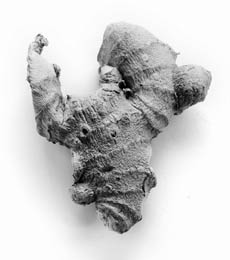Garden Spice
Gingers and Their Ilk
The weather has certainly been off-again, on-again in the heat department. The trend, however, is toward warmer and warmer (those bouts of fog notwithstanding). The time to enjoy the exotic flowers of gingers comes soon. And the season to plant them is now while the soil is warm.
The spice known as ginger is harvested from the thick underground stems of Zingiber officinale. It is possible to grow plants using fresh stems purchased from the supermarket. Be patient; it will take some months before the plant is sizable enough to harvest any of the pungent rhizomes. It is listed as hardy to Zone 8 on the USDA map (at the coast we are mostly in Zone 10), but dormant plants may rot in our cool, wet winters. Container growing may be the solution, or harvest all the tubers in late fall and replant in spring. The flowers are rarely seen and not showy, and plants are not as handsome as some of its relatives. Other members of this genus may also perform adequately here. Z. mioga is prized for its edible qualities, but it is the flowers of this species that are used to garnish Japanese traditional dishes. You may also find selections of ornamental species such as Z. neglectum, Z. niveum, Z. spectabile, Z. vinosum, or Z. zerumbet.

There are also a number of ornamental relatives in several other genera. Many of them grow only in the tropics where temperatures remain warm and moisture is constant. Luckily for us, though, there are some that will thrive here. Two of the most readily available species are Hedychium coronarium (white ginger lily) and H. gardneranum (kahili ginger). Both have sturdy stalks with large, tropical-looking leaves and, in late summer, bloom with 6- to 18-inch-long flower spikes. Both the pure white blossoms of the white ginger lily and the pale yellow kahili flowers are powerfully and seductively fragrant. They perfume the air outdoors and last many days inside to add their scent to flower arrangements. H. coccineum is also easy to grow and, while not fragrant, is equally beautiful in the landscape. After the orange-red flowers are gone, the flower stalks often make keikis, or small bulblets that can be potted up and shared with friends. Lest you think these gingers are too water thirsty, the opposite is true. They are remarkably drought tolerant. Keep them well mulched and at least partially shaded and they will survive quite well through the dry summer months.
Another genus of interesting ginger relatives is Alpinia, or shell ginger, named for the clusters of curving, shell-like flowers. The most commonly found species is A. zerumbet, either as an all-green form or with lovely stripes of white and cream running through the leaves. In specialty catalogs, you may find other species to try, including A. galanga. This is the source of galangal, another spice used often in Thai and other Asian cooking. It is reported to be very hardy, but, again, even though it can withstand freezing temperatures, may dislike prolonged cold and wet conditions.
All these gingers grow to be clumps of stalks, usually from five to even 12 feet in height. There are also some more diminutive relations. One of the easiest to grow here is Globba winitii. Sometime known as “dancing girls,” the complex arching inflorescences are covered in purple bracts and the flowers themselves are mostly sexual parts, poking and curling out to catch the breeze. There are several named selections including one that has pure white bracts to set off the yellow flowers. Globba is dormant during the winter months, so grow it in containers or remember where you planted it so it remains undisturbed during its rest period.
Another genus of gingers is Kaempferia. The majority of these will also require a dormant period and are somewhat iffy in our region. They might do better as house plants here. They have widely oval leaves that either lay flat on the ground or grow to only a few inches in height. Several have interestingly patterned and variegated leaves and resemble hostas.
Widely grown as hot-house plants, even in the tropics, is Curcuma. They generally have showy flower stalks with a waxy look and grace hotel lobbies and bank counters in Hawai’i and elsewhere. Mostly the flowers are inconspicuous, but they are enclosed in cup-like or petal-like bracts in bright hues. One of these is also a source of a spice. C. domestica rhizomes are processed to produce the bright yellow dye and culinary seasoning turmeric. With careful selection and reasonable accommodation to their exotic origins, it is possible to have a taste of the tropics in our gardens and perhaps even in our kitchens by planting gingers.



